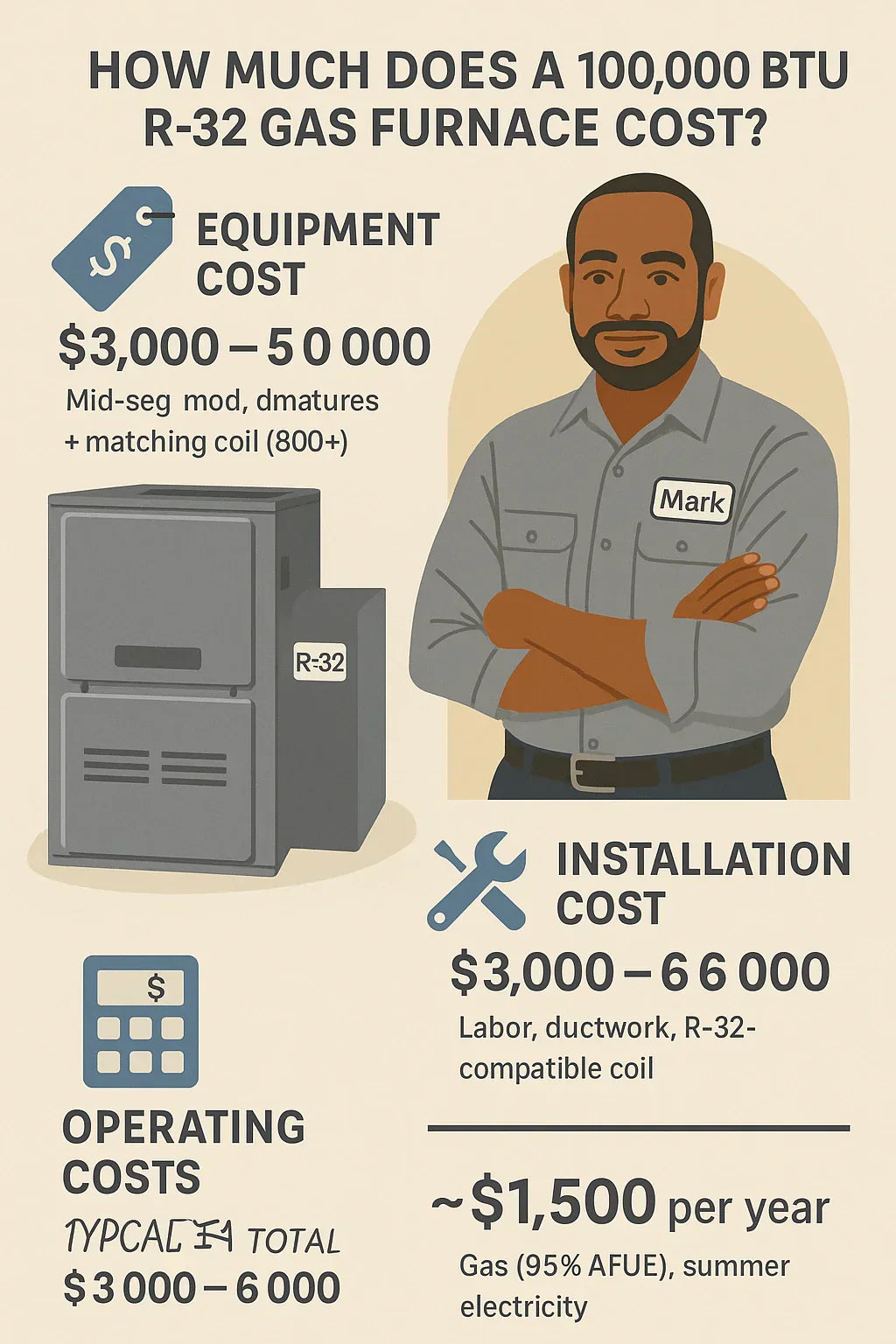1. 🏠 Why Cost Transparency Matters
When Mark started shopping for a 100,000 BTU gas furnace, he quickly realized that the number on the price tag wasn’t the whole story.
Between equipment selection, installation labor, permits, and long-term operating costs, the real investment in a new heating system can vary by thousands of dollars.
And with the shift to R-32-compatible systems in 2025, pricing dynamics are changing—both for new units and for long-term maintenance.
Mark’s takeaway:
“If you only budget for the furnace itself, you’re going to be blindsided later. You’ve got to know the whole cost picture.”
2. 📦 Equipment Costs – Your Upfront Purchase
The first number most homeowners see is the unit cost of the furnace. For a 100,000 BTU R-32-compatible gas furnace, prices depend on efficiency rating, features, and brand.
| Furnace Type | AFUE Rating | Typical Price Range (Unit Only) |
|---|---|---|
| Standard Efficiency (80–83%) | Mid-efficiency | $1,500 – $2,500 |
| High Efficiency (90–98%) | Condensing furnace | $2,500 – $4,500 |
| Premium Feature Models | Two-stage or modulating burners, ECM blower | $3,500 – $5,500 |
R-32 Compatibility Note:
Even though furnaces themselves don’t use refrigerant, an R-32-compatible furnace is paired with coils and AC/heat pump systems designed for R-32. This adds to cost because:
-
You may need a new matching evaporator coil.
-
Line set upgrades may be required (Goodman R-32 Facts PDF).
3. 🛠 Installation Costs – The Professional Setup Factor
The biggest variable in your total budget is installation labor. Mark learned that installation costs are regionally dependent, but also driven by:
-
The complexity of venting.
-
Whether ductwork is reused or replaced.
-
The need for refrigerant line upgrades.
3.1 Typical Labor Ranges (Unit Replacement)
| Installation Type | Typical Cost |
|---|---|
| Basic Replacement (reuse ducts & venting) | $1,200 – $2,000 |
| Moderate Upgrade (minor duct/vent changes) | $2,000 – $3,500 |
| Full Replacement (ductwork, venting, coil upgrade) | $3,500 – $6,000 |
R-32 Factor:
If you’re switching from R-410A to R-32, you’ll likely need:
-
New refrigerant lines to meet A2L refrigerant safety standards
-
A coil rated for R-32 operating pressures.
4. 📜 Permits, Codes & Inspection Fees
Mark’s contractor reminded him that HVAC permits aren’t optional—local codes require them for safety and compliance.
Typical Costs:
-
$50 – $500 depending on city/county.
-
Higher in areas with multiple inspections (rough-in + final).
For R-32 installs, inspectors may specifically check:
-
Proper refrigerant labeling.
-
Ventilation and leak detection compliance for A2L refrigerants (AHRI Low-GWP Guidance).
5. 📅 Ongoing Operating Costs
Mark didn’t stop at purchase—he wanted to know what it costs to run a 100,000 BTU furnace.
5.1 Gas Consumption Estimate
-
At 95% AFUE, a 100,000 BTU furnace delivers 95,000 BTU/hr output.
-
In a cold-climate winter (~1,000 heating hours/year), that’s:
-
At $1.50/therm (U.S. avg. Jan 2025), annual gas cost ≈ $1,500 (U.S. EIA Natural Gas Prices).
5.2 Summer Electric Costs (Cooling)
-
Paired with R-32 AC/heat pump, summer cooling bills may be 5–10% lower than with R-410A, thanks to higher refrigerant efficiency (Daikin R-32 Energy Study).
6. 🛡️ Warranty & Protection Plan Costs
Mark’s advice: Don’t skip the warranty math.
-
Manufacturer warranties: 10 years parts, limited heat exchanger lifetime.
-
Labor warranties: Often only 1 year unless you purchase extended coverage.
-
Extended service plans: $150 – $400/year, or $1,000+ for multi-year coverage.
High-efficiency R-32 systems may have separate warranties for the refrigerant components—check fine print.
7. 📉 How R-32 Can Reduce Long-Term Costs
Mark identified three ways R-32 systems could save money over 10–15 years:
-
Lower Summer Energy Bills – Better heat transfer = shorter cooling cycles.
-
Cheaper Recharge Costs – R-32 is a single-component refrigerant, making servicing simpler and reducing waste
-
Avoiding R-410A Price Inflation – As R-410A phases out, servicing costs will rise (ACHR News Refrigerant Phaseout).
8. 💳 Financing & Incentives
Federal Tax Credit:
High-efficiency furnaces (≥97% AFUE) can qualify for $600 federal tax credit under the Inflation Reduction Act (EnergyStar.gov IRA Incentives).
Local Rebates:
Many utilities offer $200–$1,200 rebates for upgrading to high-efficiency systems.
Financing:
HVAC dealers often offer:
-
0% interest for 12–18 months.
-
Long-term plans (5–10 years) at 4–8% APR.
9. 📊 Mark’s Real-World Budget Example
For Mark’s 2,000 sq ft home in a cold Midwestern climate:
| Item | Standard Efficiency | High Efficiency (R-32 Compatible) |
|---|---|---|
| Furnace Unit | $1,800 | $3,200 |
| Matching Coil | $0 (reuse) | $800 |
| Installation Labor | $2,200 | $3,500 |
| Permits/Inspection | $250 | $300 |
| Total Upfront | $4,250 | $7,800 |
| Annual Operating (Gas + Electric) | $1,750 | $1,500 |
| 10-Year Op. Cost | $17,500 | $15,000 |
| 10-Year Total | $21,750 | $22,800 |
Note: The high-efficiency R-32 system cost slightly more over 10 years but provided better comfort, lower emissions, and higher resale value.
Mark’s Closing Advice:
“Don’t just hunt for the cheapest furnace. Price out the whole system, installation, and what it’ll cost to run for a decade. And if you’re going R-32, make sure your contractor is trained for A2L refrigerants—you’ll get better performance and safer installs.”
In the next topic we will read more about: Installation Guide: What to Know Before You Replace Your Gas Furnace







